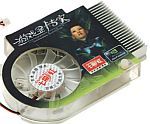It’s true. I like them. If I were an electrical apparatus I’d like them more. Electronics and heat go together, but they don’t like it.

Heat in electronic gear causes many problems. They can often be subtle, like the gear ‘acts up’ after a while. It could be the VCR or DVD player that produces streaks in the picture after some time running or the hanging/rebooting pc in the back room.
Recently my own DVR started carrying on. The first symptom was it wouldn’t play any previously recorded material. A closer look showed that it thought the program names were written in a mixture of 5 foreign languages and were 350GB long. That would havebeen great except I knew it had only a 160GB hard disk drive in it. I tried to delete some of the old stuff but no, it wouldn’t delete. After some time I thought I’d try to format the hdd, but oh no, it wouldn’t allow that either. At that point I was getting quite frustrated and started to pull it out of the timber entertainment unit it was in. As soon as I put my hand on it I could feel that it was quite warm. Not really blazingly hot, but way too warm. After letting it cool in free air for a while it magically worked normally and has continued to work normally since. Another victim of heat causing problems with electronics.
Consumer electronics like DVD players, HiFi gear and most TV’s (Plasma’s are an exception) are made cheaply and generally heat disappation is not of paramount concern in the manufacturers mind. Maybe they’re made for a cooler climate than Australia, where I live, but here things get hot.
Computers on the other hand have at least 1 fan, in the power supply. Well, unless you’re a noise freak, that’ll be the case. That fan has a dual purpose. Not only does it extract warm (or hot) air that has been heated from the components inside the power supply, but the air that it draws in (if it can! ) is already warm from the other electronics inside your computer. So now we’re drawing in already warm air over warm components that need to be cooled. Hmmm…. Not good. As I said before, if the power supply in question, as is common, has its intake vents partially clogged with dust and crud then less air can be drawn in.
Modern computers have more than one fan. As computers get faster they generate more heat. It’s a fact of life with electronics. CPU’s (the “brain” inside your computer), the Pentium 4, Core 2 Duo, Centrino, Phenom or what have you, all do it. They get hot. In some designs if they get hot they go slower, others destroy themselves.
To get rid of the heat, metal heatsinks are fitted. These come in many designs but generally have some sort of fins that extend away from the heat source to allow the heat to dissipate. Modern multi-gigahertz (fast) cpu’s generate a whopping amount of heat and not only have a heatsink but an integrated fan too. So now we have the cpu stirring warm air around that will be drawn into the power supply. If your computer is used for modern 3D games, then it very likely has a fan (or 2) on the video card too. Fast video cards, like fast CPU’s generate a LOT of heat. Now we have several sources of heat in the computer. Don’t forget hard disk drives too. They get quite hot but their heat is generally drawn away by the metal chassis of the computer that they’re mounted into.
Some computers may have a fan mounted at the front to draw in (hopefully) cool outside air. They may also have 1 or more extra exhaust fans at the rear of the case. It seems that no matter how many you have, it’s not quite enough.
Now let’s throw into the mix a warm summers day. As I’ve often said to clients, if you are uncomfortably warm, your computer is frying. Should one of the fans fail you are in strife.
The most common fans to fail are the power supply fans. While CPU fans don’t tend to fail, their heatsinks do get heavily clogged up with dust and fluff. Regular cleaning is a good idea, but don’t do as recommended in a local supposedly hi-tech magazine and wash your motherboard under running water. Can you believe that nonsense? Call a professional (and I don’t mean a maid) to do it.
Get to know how warm your system runs. It may save you a lot of heartache.


